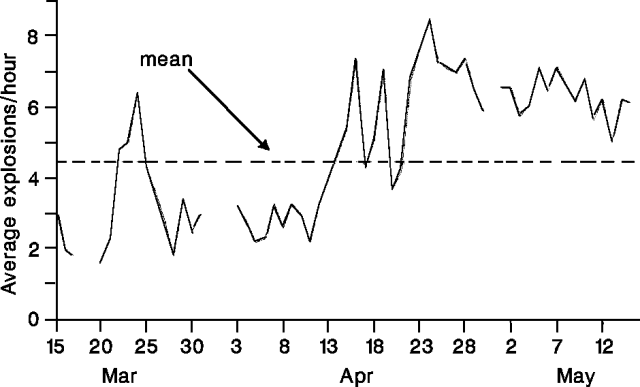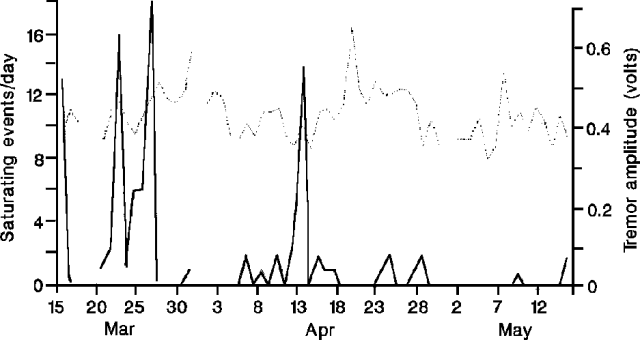Report on Stromboli (Italy) — May 1991
Bulletin of the Global Volcanism Network, vol. 16, no. 5 (May 1991)
Managing Editor: Lindsay McClelland.
Stromboli (Italy) More frequent explosions
Please cite this report as:
Global Volcanism Program, 1991. Report on Stromboli (Italy) (McClelland, L., ed.). Bulletin of the Global Volcanism Network, 16:5. Smithsonian Institution. https://doi.org/10.5479/si.GVP.BGVN199105-211040
Stromboli
Italy
38.789°N, 15.213°E; summit elev. 924 m
All times are local (unless otherwise noted)
The number of seismically recorded explosions increased briefly in late March and persistently from mid-April (figure 13). After mid-April, the number of earthquakes exceeding instrument saturation level decreased from an average of ~20/day since January to
 |
Figure 13. Average number of seismically recorded explosion events/hour at Stromboli, 15 March-15 May 1991. The mean value for the period is shown. Courtesy of M. Riuscetti. |
 |
Figure 14. Daily number of seismometer-saturating events (lower curve); and average tremor amplitude (upper curve) at Stromboli, 15 March-15 May 1991. Courtesy of M. Riuscetti. |
Volcano guides reported infrequent small explosive activity at the 3 craters during visits to the summit on 10, 15, and 16 April, and 1 May. In early May, the first complete gas sampling at Stromboli was made during an inter-explosive phase at fumaroles (410°C) on the NW rim of the active crater complex (table 1).
Table 1. Chemical composition (in volume %) of fumarolic gases from Stromboli, early May 1991. Courtesy of M. Martini.
| Gas | Volume % |
| H2O | 60.29 |
| CO2 | 29.68 |
| H2S | -- |
| HCl | 0.28 |
| HF | 0.041 |
| H2 | -- |
| N2 | 6.90 |
| O2 | 1.29 |
| B | 0.0014 |
| Br | 0.00017 |
| CO | 0.00007 |
| NH4 | 0.00006 |
| CH4 | -- |
Local residents reported a significant increase in the number of explosions on 19 May, after several weeks of weak activity. During a visit to the summit on the evening of 21 May, frequent strong explosions were observed at craters 1 and 3, with large ejections of incandescent material. Thirty explosions were counted between 2000 on the 21st and 0600 the next day. Many ejecta fell onto the N flank's Sciara del Fuoco. Crater 2 and the small cones continuously emitted gas and vapor.
Geological Summary. Spectacular incandescent nighttime explosions at Stromboli have long attracted visitors to the "Lighthouse of the Mediterranean" in the NE Aeolian Islands. This volcano has lent its name to the frequent mild explosive activity that has characterized its eruptions throughout much of historical time. The small island is the emergent summit of a volcano that grew in two main eruptive cycles, the last of which formed the western portion of the island. The Neostromboli eruptive period took place between about 13,000 and 5,000 years ago. The active summit vents are located at the head of the Sciara del Fuoco, a prominent scarp that formed about 5,000 years ago due to a series of slope failures which extends to below sea level. The modern volcano has been constructed within this scarp, which funnels pyroclastic ejecta and lava flows to the NW. Essentially continuous mild Strombolian explosions, sometimes accompanied by lava flows, have been recorded for more than a millennium.
Information Contacts: M. Riuscetti, Univ di Udine; M. Martini, Univ di Firenze; H. Gaudru, Société Volcanologique Européenne (SVE), Switzerland.

